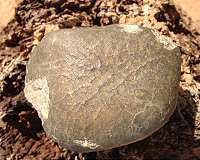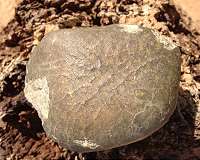A team of European researchers discovered a new high-pressure mineral in a lunar meteorite which is helping to explain what happens to materials within the extreme pressures of the Earth’s mantle.
The new mineral donwilhelmsite is the first high-pressure mineral found in meteorites with application for terrestrial sediments dragged deep into the Earth mantle by plate tectonics. Mainly composed of calcium, aluminum, silicon, and oxygen atoms, donwilhelmsite was discovered within the lunar meteorite Oued Awlitis 001 found in 2014 in the Western Sahara.
The meteorite is compositionally similar to rocks comprising the Earth’s continents. Eroded sediments from these continents are transported by wind and rivers to the oceans, and subducted into the Earth’s mantle as part of the dense oceanic crust.
Once dragged to depths of about 460-700 km, their constituent minerals transform at high pressures and high temperatures existing at those depths into denser mineral phases, including the newly discovered mineral donwilhelmsite. In the terrestrial rock cycle, donwilhelmsite is therefore an important agent for transporting continental crustal sediments through the transition zone of the Earth’s mantle (460-700 km depth).
Around 382 kilograms of rocks and soils have been collected by the Apollo and Luna missions, lunar meteorites allow valuable insights into the formation and evolution of the Moon. Ejected by impacts onto the lunar surface and subsequently delivered to Earth, some of these meteorites experienced particularly high temperatures and pressures.
Dr Vera Assis Fernandes of The University of Manchester measured the Argon isotopic composition of lunar rocks to date their complex history including magmatic formation, multiple impact bombardments, and the exposure to cosmic rays on the lunar surface, over billions of years. Dr Fernandes explains: “During impact bombardment rocks like the lunar meteorite Oued Awlitis 001 experience extreme physical conditions. This often led to shock melting of microscopic areas forming veins or melt pockets within these meteorites.
“These shocked areas are of great relevance as they mirror pressure and temperature regimes similar to those prevailing in the Earth’s mantle, and therefore are natural crucibles hosting minerals that are otherwise naturally inaccessible at the Earth’s surface.”
The new discovery is published in the journal American Mineralogist. This pan-European collaboration was essential to obtain the lunar meteorite, recognise the new mineral, understand its scientific relevance, and to determine the crystal structure of the tiny, thousands parts of a millimeter thick, mineral crystal with high accuracy.
Mariana Klementova applied the cutting edge 3D electron diffraction (3DED) technique, together with a specially developed software to solve, for the first time, the crystal structure of an extraterrestrial mineral. Dr. Vera Assis Fernandes determined the ages of various events in the complex history of this meteorite, including the formation of the new mineral donwilhlemsite.
The new mineral was named in honor of the lunar geologist Don E. Wilhelms, an American scientist involved in landing site selection and data analyses of the Apollo space missions that brought to Earth the first rock samples from the Moon. Part of the meteorite Oued Awlitis 001 is now on display at the Natural History Museum Vienna.
Research Report: “A new lunar high-pressure Ca-Al-silicate with relevance for subducted terrestrial sediments”
Related Links
Mars News and Information at MarsDaily.com
Lunar Dreams and more
|
Thanks for being here; We need your help. The SpaceDaily news network continues to grow but revenues have never been harder to maintain.With the rise of Ad Blockers, and Facebook – our traditional revenue sources via quality network advertising continues to decline. And unlike so many other news sites, we don’t have a paywall – with those annoying usernames and passwords.Our news coverage takes time and effort to publish 365 days a year.If you find our news sites informative and useful then please consider becoming a regular supporter or for now make a one off contribution. |
||
|
SpaceDaily Contributor $5 Billed Once |
SpaceDaily Monthly Supporter $5 Billed Monthly paypal only |
|
NASA Crowdsources with HeroX to Find Solutions for Unloading Lunar Goods
Houston TX (SPX) Oct 30, 2020
HeroX, the social network for innovation and the world’s leading platform for crowdsourced solutions, has launched the crowdsourcing competition “NASA’s Lunar Delivery Challenge” on behalf of the NASA Tournament Lab (NTL) and NASA’s Langley Research Center.
The goal of NASA’s Artemis program is to land the first woman and the next man on the surface of the Moon in 2024. By the next decade, NASA hopes to establish a sustained human presence on the Moon. In order to do that, a way to unload all of t … read more
– Advertisement –


